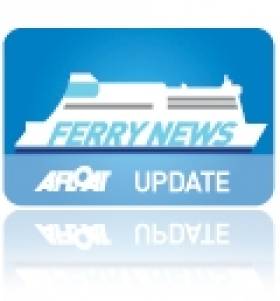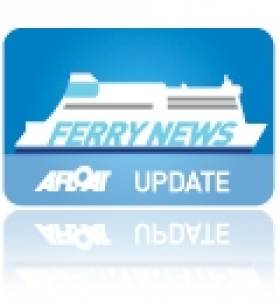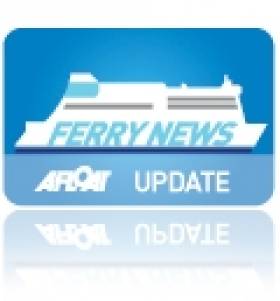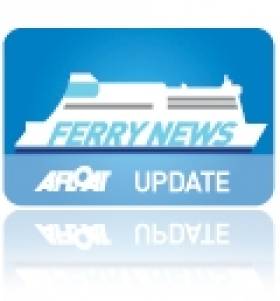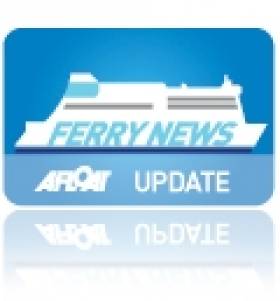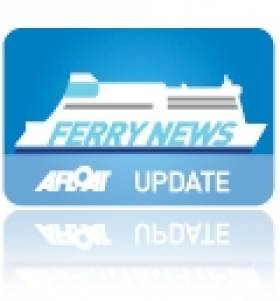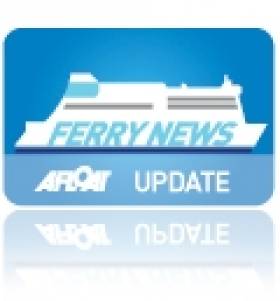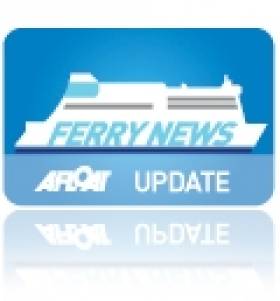Displaying items by tag: Cancelled Sailings
Cancelled Irish Sea Fast-Ferry Sailings & Disruption on Isle of Man Route
#CancelledSailings – Met Eireann's marine weather foreceast currently has an 'orange' status warning of a gale in effect which has caused some cancellation of ferry sailings on the Irish Sea. In addition, the weather service has issued a 'yellow' warning for small craft.
The weather has caused cancellation of today's Irish Ferries high-speed craft Jonathan Swift operated sailings on the Dublin-Holyhead route. Passengers, however will be transferred to Ulysses conventional ferry sailings which continue to operate as normal. For latest information, click HERE.
Due to adverse weather conditions the Isle of Man Steam Packet Co.'s route between Douglas and Heysham have also led to cancelled sailings operated by the ro-pax ferry Ben-My-Chree. Todays 14.15 sailing from Douglas has been cancelled.
In addition further possible disruption may arise on the UK-Isle of Man link, on sailings later today and for tomorrow (Tuesday, 24 February), to consult latest information updates, click HERE.
Travellers are advised to check other ferry operators (listed below) for the latest sailing information updates.
For details of Met Eireann's coastal reports and conditions for sea crossing's forecast visit this LINK.
Bad Weather Causes Widespread Ferry Cancellations on Irish Sea
#CancelledSailings – Met Eireann has issued a status 'orange' warning of gale to storm force winds tonight on all Irish coastal waters, which have led to widespread cancellation of ferry sailings across the Irish Sea.
Passengers are advised to consult for up to date information as sailings are cancelled tonight and for tomorrow (January 15). For up to date sailing information, click the ferry operator websites listed below.
Those travelling with Irish Ferries, should also take note that in addition to cancelled conventional sailings, the operators Dublin-Holyhead 'Swift' fast-ferry crossings are currently not in service as Jonathan Swift is on scheduled annual maintenance.
She headed for dry-docking in Birkenhead, where Ulysses as previously on Afloat.ie is also undergoing annual overhaul.
Isle of Man-England services are also effected to the adverse weather, with Isle of Man Steam Packet sailings on the Douglas-Heysham route cancelled today.
Further disruption and cancelled sailings (subject to which crossing) also apply to sailings tomorrow (January 15).
To recap, passengers are advised to check latest sailing information from the following website links:
Irish Ferries, Stena Line, P&O Ferries and the Isle of Man Steam Packet Co.
For additional information details are available by visiting the AA's ferrywatch service HERE
For weather forecasts visit Met Eireann's coastal reports and sea crossing's forecast visit this LINK.
#CancelledSailings – Met Eireann continues to issue a status ‘yellow’ gale warning in effect for its marine weather forecast. Due to the adverse weather this has led to cancellation of fast-ferry sailings on the Irish Sea and on certain sailings served by conventional ferry.
In addition Isle of Man-England services today are cancelled and potentially face further disruption or cancellation tomorrow (Saturday 10 Decenber).
For details of Met Eireann’s coastal reports and sea crossing’s forecast visit this LINK.
Ferry travellers are advised to check for latest sailing information updates from the following ferry operator websites listed below.
Isle of Man Steam Packet Company
For additional information, visit the AA's ferry travel check service HERE
Gale Force Weather Conditions Cancel Some Irish Sea and Continental Sailings
#CancelledSailings – As a gale warning is in effect this has led to some cancelled fast-ferry and conventional sailings on the Irish Sea in addition to some sailings to and from France.
Due to the adverse weather conditions Isle of Man sailings on the Douglas-Heysham single ro-pax served route, have been cancelled today with potential further disruption or cancellation to crossings tomorrow.
Travellers are advised to check for latest sailing information updates from Irish Sea operators by clicking these following website links below:
Details are also available by visiting the AA's ferrywatch service HERE
Click this link for Met Eireann weather including coastal reports and sea crossing's forecast.
Cancelled Sailings: Irish Ferries 'Fast-Ferry' Operated Sailings
#CancelledSailings – Certain fast-ferry operated sailings on the Irish Sea today and for tomorrow (Tuesday 26 September) are cancelled due to adverse weather conditions.
Irish Ferries have cancelled tomorrow's fast-ferry only operated sailings otherwise served by Jonathan Swift on the Dublin-Holyhead route.
Instead all passengers are to be accommodated on the alternative cruise-ferry Ulysses which will be operating to service as normal. For further information on sailing times consult the Irish Ferries website HERE.
As the Autumn season is underway, any further disruption to sailings can also be consulted on the 'AA website' which provides daily updates and contact details of the various travel operators by 'scrolling down' their website page HERE.
#CancelledSailings – Irish Ferries ro-pax Epsilon sailings on the Dublin route to Wales are cancelled and to France this weekend, the operators are citing technical reasons, writes Jehan Ashmore.
Last night's round trip Dublin-Holyhead sailings were cancelled and throughout today on the Welsh service. Irish Ferries regrets also to advise sailings on this weekend's round trip Dublin-Cherbourg route are cancelled too.
All effected passengers on the Dublin-Holyhead service will be accommodated instead on their High Speed Craft, HSC Jonathan Swift and sailings served by flagship cruiseferry, Ulysses.
For the latest information on sailing schedules, including Irish, UK and French contact telephone lines, visit this Irish Ferries website link.
Epsilon remains berthed in Dublin Port, having shifted berths from the ferryport to an opposite quay and so to free up the linkspan used by other ferries.
LD Lines France Route Ro-Pax to Have Annual Dry-Docking
#FerryDryDock – According to LD Lines website, the ro-pax Norman Atlantic is to have its annual drydocking and the following sailings listed below on the Rosslare-St.Nazaire route are cancelled.
Rosslare - St Nazaire: 14 & 21 March
St Nazaire - Rosslare: 12 & 19 March
Click for LD lines contact details.
To consult the latest sailing schedule on the Rosslare-St. Nazaire route click HERE.
For those travelling on the route beyond France of the 'landbridge' Spain service of St. Nazaire- Gijón, they should be advised that 'certain' sailings are also cancelled.
Also operating the St. Nazaire-Gijón route is sister ro-pax, Norman Astuarias which will continue to serve to her sailing schedule.
To consult the latest sailing schedule on the St. Nazaire- Gijón route click this link.
As previously reported on Afloat.ie, Norman Atlantic as the former Scintu in January had launched LD Lines new Ireland-France-Spain routes, the services becoming the first ever to link all three countries. That first sailing by Scintu to Rosslare was a once-off as was renamed Norman Atlantic to reflect her trading route network.
Norman Atlantic is pictured here along the inner pier of Rosslare Europort. She is clearly recognisable as one of the Visentini built designed ro-pax vessels.
The Italian shipyard built ferries are designed primarily with ro-ro freight in mind and a relatively small passenger capacity compared to conventional car-ferries. The ro-pax have become increasingly popular in recent years, notably earlier this year by other operators trading from the Wexford port.
More Bad Weather and Maintenance Lead to Cancelled Sailings
#CancelledSailings – As yet another gale warning is in effect some ferry sailings have been cancelled today on the Irish Sea and on French services.
Travellers are advised to check for updates on the latest sailing information from Irish Sea operators by clicking these following website links for Irish Ferries, P&O Ferries and Stena Line.
Passengers on Stena Line's Belfast-Cairnryan route take note that due to essential ferry maintenance, the following sailings (to Scotland) at 11.30 and 19.30 for this weekend (15-16 Feb.) have been cancelled.
On the Ireland-France service, Celtic Link Ferries sailing tonight from Cherbourg (21.00) to Rosslare has been cancelled due to adverse weather conditions.
In addition further details are also available by visiting the AA's ferrywatch service.
Stormy Start to February Cause Cancelled Sailings
#CancelledSailings - As yet another storm batters the coast, some ferry sailings have been cancelled today and for tomorrow on the Irish Sea.
Travellers are advised to check for updates on the latest sailing information from operators by clicking these following website links for Irish Ferries, Stena Line and P&O Ferries.
In addition further details are also available by visiting the AA's ferrywatch service.
New Year Storms Cause Cancelled Ferry Sailings
#CancelledSailings – Only days into the New Year sees the return of bad weather as storm force winds and gales batter the coast, forcing fast-ferry operated sailings to be cancelled today.
On the Dublin Port-Holyhead route, Irish Ferries fast-ferry Jonathan Swift sailings have been cancelled and on the Dun Laoghaire-Holyhead Stena Line's fast-craft HSS Stena Explorer sailings have also been cancelled.
Passengers booked on both of the company's fast-ferry operated sailings will be accommodated on alternative cruiseferry sailings that also operate between Dublin Port and Holyhead.
Those intending to travel on P&O Ferries routes, are asked to contact the operator's Travel Information and Weatherline service on +44 (0)845 832 8888.
To confirm the latest sailing updates it is advisable to visit the following ferry operator websites: Irish Ferries Stena Line in addition to updates available from the AA's ferrywatch page.


























